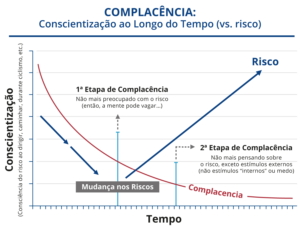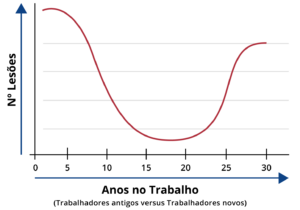Hi, and welcome back. In the last article we looked at serious injuries, the contributing factors and just how often mind not on task and eyes not on task were involved, or at least how often they were both involved in the serious injuries that have happened to us (almost every one). And if it’s of any comfort, the same questions have been asked to over a million people in 66 countries, so you’re not alone. The same two critical errors that contributed to your serious injuries also contributed to theirs (and mine).
In this article, like in the first four of this series, you will find a couple of new ideas or paradigm shifts that are somewhat counter-intuitive or almost the opposite of what most people think, that we will explore in more depth. We will also look at some practical, extremely cost effective (free) ways to reduce serious injuries 50% or more. But for now, let’s go back to the last article and the importance of those first two critical errors, eyes and mind not on task.
What we found was that for almost all of us, if we exclude sports, eyes not on task and mind not on task were involved in a very high percentage of our serious injuries, whether they were at work, at home, in the community or on the road. But it doesn’t seem quite right (almost misleading) to say that these two critical errors were just “involved”, because we are never trying to get seriously hurt anywhere or anytime! It’s more like these two errors had to happen or that they have to happen at the same time. Otherwise, if we see it coming, we will almost always get the benefit of our reflexes—which, in most cases, will be enough to prevent a direct hit, blind fall or a head-on collision.
This is not to say that these two critical errors by themselves cause all the serious injuries and fatalities. There are always at least two (or more) contributing factors. But quite often those other factors like the type of hazardous energy: electrical, mechanical, thermal and amount or kind of protection vary considerably as you go from burn to fall to motor vehicle accident. Whereas the first two critical errors, eyes and mind not on task—happening at the same time—are involved in almost every one. And since mind not on task is bound to happen if you know how to do something well, there is much more “leverage” or efficiency in getting people to put some additional effort or more effort than they are currently making (none) into improving their safety-related habits: like moving their eyes first, before they move, looking for line-of-fire potential before moving, looking for things that would cause them to lose their balance, traction or grip, etc.
FAVORABLE LEVERAGE:
In so many cases, one glance or one quick look—that didn’t happen—like someone not seeing a train or a pedestrian (or anything in between) and we’re reading, at least in the local paper, about another “tragedy”. So, if eyes on task is so important—and we all know it is—we prove it to ourselves over and over every time we bump into something, bang our shin or stub our toe. It’s not like we don’t know, or that someone else feels the pain. And yet, very few adults—unless they are informed, trained and motivated—are making any effort to improve their habit and skills with eyes on task. Just think of the adults you know: do any of them talk about improving their habits with visual focusing? Do they realize how important it is? Are they doing anything about it to prevent making both of these critical errors at the same time? Or do they think they’re safe enough already? Have they ever asked you for some safety advice? Funny: even though all my friends and extended family know I’m a safety expert, they’ve never asked for any advice… hmmm.
Okay, so maybe not everybody thinks they’re safe enough already, but most adults do—and for good reason: we all got hurt a lot when we were young, in terms of accidental cuts, bruises, bumps and scrapes. Not all of them needed first aid, like a Band-Aid. Some needed more, like stitches or staples and some needed less.
If you go to the drugstore, you will see that they sell “family packs” of Band-Aids and then there are smaller packages with only 3-5. These smaller packages are not labelled family pack. The reason the family pack is much bigger is because most little kids are getting hurt or experiencing pain from an accidental injury about 15-25 times a week, usually with 5-10 that “left a mark” (cut, bruise, scrape, burn), which is why you need a lot of Band-Aids. Whereas most adults will only experience one or two a week with only one or maybe two per month that left a mark. Some adults can even go two months without a visible cut, bruise, burn or scrape, but it’s rare. Or another way of looking at it, what’s the longest period of time you’ve gone through without a cut, bruise or scrape? Probably not a whole year, but even if you’re really high for an adult and it’s as many as two or three a month, the point is it’s not a high number any more. We have gone from about 20 cuts, bruises and scrapes per week to about 20 a year. That’s a 5000% improvement! (Imagine seeing that on your paycheque!) No wonder most adults think they’re safe enough already. And if you think you’re safe enough already, it makes sense that you wouldn’t necessarily be all that motivated to put some additional effort or any effort into improving your habits and skills with eyes on task. But we did get 5000% better. How did that happen and why did it stop? We know it stopped. Adults do not—as a rule—put any effort into improving their personal safety skills and habits. But that doesn’t mean it had to stop. It just did.

Imagine what would happen if every time you turned or moved without looking first you hit something. Even if it didn’t hurt, how long do you think it would take before you started looking every time? Probably not even the 21-28 days they say it takes to develop a new habit. If you added some pain to each one like you got an electric shock every time, it would probably happen much quicker than the proverbial 21-28 days. But we don’t bump into something or somebody every time. So we start to improve rapidly when we are young and as we get better, the frequency of problems gets less, the pain is therefore less frequent and eventually, we all find our own equilibrium. And after that, in terms of personal safety skills and habits, most people stop improving. But the concept of equilibrium doesn’t stop with human error or critical errors like eyes not on task.
EQUILIBRIUM/SAFE ENOUGH:
The concept of equilibrium also spills over into decision making: if we think we’re going too slow, we put our foot on the gas, and if we think we’re going too fast, we put our foot on the brake, and eventually, everyone that drives faster than us is an idiot and everyone who drives slower is a wiener. And after that, just like with the errors, the questioning of the judgement and hence, the improvement in judgement stops, which compounds or reinforces the “I’m safe enough” perspective. So it all makes sense in terms of why we’re not getting any better with experience, but that’s not the way most people think. And this is a huge, somewhat painful or at least disappointing paradigm shift.
Imagine being at a family dinner. The son-in-law is arguing: “Well, I should know, I’ve been driving for 12 years…” to which his fatherin-law says, “Yeah, well I’ve been driving for 36!” As if, for some reason that would make him any better or safer. But part of the paradigm shift here is that we sensed the risk of driving going down in those first few years as we got more skilled. (See Figure #1)
It’s only natural that we would think that the risk would just continue to go down as we gained even more experience, which is why the father-in-law believes his additional 24 years makes him better/safer. When in reality, the risk of the two critical errors happening at the same time is actually going up. And the reason that this is somewhat painful or disappointing is that most people (most of us) think or would like to think that our experience is an asset. And overall, on balance and from many aspects—it is. But unfortunately, from a neuroscience (reticular activation system) point of view, experience can make keeping your eyes on task and mind on task very, very difficult—especially in familiar surroundings.
As soon as you can do something well, or to put it another way, as soon as the skill or fear is no longer pre-occupying, your mind can wander. What is probably the most interesting or shocking thing about this is that it happens without our permission. It’s not like we’d been driving for two years and said, “I got this, now I can start thinking about something else besides driving…” It just happened! Without our permission or any conscious thought—we just started driving on auto-pilot. What this means is that you can’t stop complacency leading to mind not on task. It’s not a character flaw. There are ways to bring your mind back on task—very efficient ways, but nothing can really stop it from happening in the first place. It’s just the way we’re “hard-wired”.
Unfortunately, the more experienced you are, the more likely it is that your mind will wander. As mentioned, you can’t stop it from happening. But we can all work on improving our habits with eyes not on task, with fairly little effort and without having to spend any money, so that our automatic behavior or habitual behavior will help to compensate for it—like leaving a safe following distance when driving. Then, even if your mind goes off task and you start driving on auto-pilot, your subconscious will keep that same safe following distance for you.
CONCLUSION:
The main paradigm shift in this article is that we all eventually “conclude” that we’re “safe enough already”, and that (ironically) from a neuroscience perspective, is just about exactly the time when the risk of making a mind not on task error and an eye not on task error at the same time starts going up. And to make it worse, most people think that the risk continues to go down as they gain even more experience, when in fact, it continues to increase. And unless it is counter-balanced with some additional effort to improve eyes on task, that means the overall risk of serious injury and/or fatality goes up, which we have seen proven in industry and on the highway—for years and years. (We know that) very experienced workers or very experienced drivers are the second highest category or risk group. (Figure #2)

Why young, untrained and inexperienced workers or drivers get hurt is easy for most people to understand. But why experienced workers or experts get seriously hurt and how often they are killed has always been a bit of a mystery or at least very difficult to explain with conventional risk assessment tools. Hopefully this paradigm shift sheds some light on the subject. More importantly, you also know what to do about it: get them to improve their safety-related habits with eyes on task. That will be a huge help. It’s not everything. As mentioned, there are a total of four critical error reduction techniques. But that’s enough for now. We’ll look at the other techniques like self-triggering in future articles.


SHARE THIS ARTICLE!